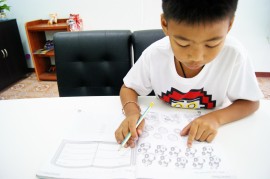
Reading is a complex cognitive process. Hence, it is but imperative that educators are knowledgeable of which reading materials and teaching strategies to use to students at different grade levels. As readers advance in grade level, so are their learning needs and competencies.
Early grades (K3)– Readers at this level are in Fries’ and Chall’s first stage of reading, which is the transfer or the decoding stage. The focus of reading instruction should be on getting the child to have a good command of the alphabet and other printed symbols (such as numbers and basic punctuation marks), phonemes and rhymes so that he/she would be able to decode these prints with as much automaticity as possible. This could be done through first, exposing the child to a print- rich environment, making him/her familiar with the prints and their graphic shapes. Focus should also be on giving specific and systematic instructions to the child as the relation between letters and sounds are initially not apparent or not automatically discovered.
In this stage, a child learns the relationship between oral and printed language. Reading materials should then cover what the child has already experienced and what he/she already knows in his/her oral language. The content of the reading materials should initially be about topics familiar or common to the target age group. According to Fries (1963) this period should provide children with opportunities for responding to visual symbols. This stage should allow children to “practice” and this can be achieved through repetitive vocabularies and patterns such as rhyming or chanting.
Middle Grades (4-7)– In this level, readers should have already achieved fluency in reading high frequency words. The focus should no longer be on basic decoding but on synthesizing and analyzing the written content. The focus should also be on improving reading comprehension through having the ability to make inferences or find meaning even though the message has no visual symbols. Students should be encouraged to react to the read materials through discussions, answering open- ended questions and writing.
This stage is the transition phase from novice towards advanced reading. Hermosa (page 161) has stated that the reader has already acquired the basics, but is still not as effective in using reading as a tool for learning. The reader then has to achieve mastery and fluency of the skills so he/she can use it effectively in learning new knowledge. The focus should then be on exposing students to reading materials with more advanced and unfamiliar vocabularies and sentence patterns. Inclusion of more complex reading materials such as short biographies and magazine articles would be a good foundation.
High School– Here, students should be able to use reading as a tool in acquiring new knowledge and in experiencing new feelings from a variety of viewpoints. Reading instruction is more rigorous on vocabulary, reading comprehension and practice to students. The focus of reading instruction should be about providing enriching reading activities to students in order for them to realize the functional purposes of reading. Students should be exposed to books or other reading materials about sciences and humanities.
REFERENCES:
Hermosa, N. N. (2006) The Psychology of Reading. UPOU, Quezon City, Phil.
Spear-Swerling, L. (2004). A road map for understanding reading disability and other reading problems: Origins, intervention and prevention. In R. Rudell & N. Unrau (Eds.). Theoretical models and processes of reading, vol. 5 (pp. 517-573). Newark, DE: International Reading Association.






